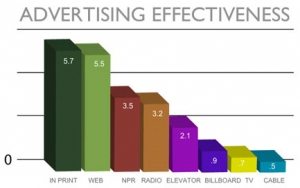Business owners often rely to(on) sales or marketing managers in creating marketing strategies that will boost the company’s sales. However, there will always be instances wherein the supposed marketing strategy will not reach its target revenues, market share goals, or the customers’ expectations. This then lead(leads) to the question, “Is the customer messaging spot-on?”. Answering this question is critical in reviewing advertising effectiveness of the company(added this sentence).
The customers’ impressions are considered as the most significant and most essential metric in determining how effective a business’ advertisement and its brand messaging is. In today’s social media era, the number of impressions are(is) now tracked through the number of clicks, shares, likes, or views of a certain advertisement. This illustrates whether the brand message reached its target consumers or if they have actually seen the ad. However, it will be a challenge to describe the impact of the advertisement to consumers who have seen the ad, but did not “share” or “like” the said advertising media.
What is Advertising Effectiveness?
Advertising effectiveness tells whether or not the advertisement succeeded in achieving its purpose. Businesses utilize different methods or metrics in evaluating advertising effectiveness which can be used for all kinds, forms, and types of advertisement media.
Measuring the Effectiveness of an Advertisement
In determining how the customers responded with the brand message or advertising media, or how they interacted with the product itself, marketers use the customer engagement metric. Basically, this metric involves brand recognition and gives an impression on the overall effectuality of the marketing campaign. But in general, there are two classifications of measures of advertising effectiveness: direct and indirect measures. Direct measures show the established relationship between sales and advertising. Usually, a defined market or period is used in comparing the changes in sales. When companies are having a hard time gauging the direct impact of the advertisement to their sales, they use indirect measures. What sets it different to direct measures is that indirect measures assess the indirect effect of the advertisement to the company’s sales using attributes such as customer awareness, brand recognition, and customer behavior, among others.
There are methods that can be employed when conducting direct measures on advertising effectiveness; there are historical sales method and experimental control. Historical sales method measures the relationship between the incurred advertising expenses with the product’s overall generated sales using a multiple regression analysis. While for experimental control, it acts as a pre-test as a way of supporting the advertisement in selecting creative designs. An example is test marketing. On the other hand, indirect measures use different factors in gauging advertising effectiveness: brand awareness, comprehension, attitude change, action, and action, among others.
Brand awareness assumes that a direct relationship exists between brand awareness and the product’s advertisement.
Comprehension evaluates the customer’s knowledge and understanding of the brand and its message.
Attitude change reflects the advertisement’s influence on the customers. This involves asking customers regarding their eagerness and enthusiasm to purchase the product or avail the service.
Action shows the customers’ intention to buy the product. The main purpose of advertisements is to prompt an intention to buy to the customers.
Creating an Effective B2B Product Message
There are three ways on how one can create an effective B2B product message. First, one must understand their target audience. The message must be established in a manner that it will connect to the consumers. Will they see the product as a direct alternative for an existing product or a mere substitute? What are their needs? Next is focusing the message. An effective product message has its attention to a single audience. If the message is targeted to different types of consumers, its effectiveness decreases. A product message must also be credible. It should convey the proof points on how the customers will benefit from the product or service.

